As one of the, if not THE, most popular freshwater fish for beginner and experienced aquarium enthusiasts alike, the guppy (Poecilia reticulata) is a colorful, hardy, and easy-to-care-for fish. However, even the best cared-for guppy is not immune to disease. Try as you might; sometimes, guppies just get sick.
The good news is that, in most cases, guppy diseases are fairly easy to treat. The key is to catch them early. Keep a close eye on your fish and take action at the first sign of illness. In this article, we’ll discuss the 17 most common guppy fish diseases, their symptoms, and how to treat them.
17 Most Common Guppy Diseases
1. White Spots (Ich)
Symptoms:
We’re all for adding a little razzle-dazzle to our guppie’s appearance, but when you start noticing white flakes or spots on their fins or bodies, that’s a cause for concern. White spots on the skin of fish are usually a sign of an ich (Ichthyophthirius multifiliis) infection, one of the most common guppy diseases. If left untreated, ich can quickly spread and decimate your entire tank.
Another key symptom of ich is scratching or rubbing against objects in the tank. This is the fish trying to rid itself of the irritating parasites. They may also lose their appetite, or start hiding more than usual.
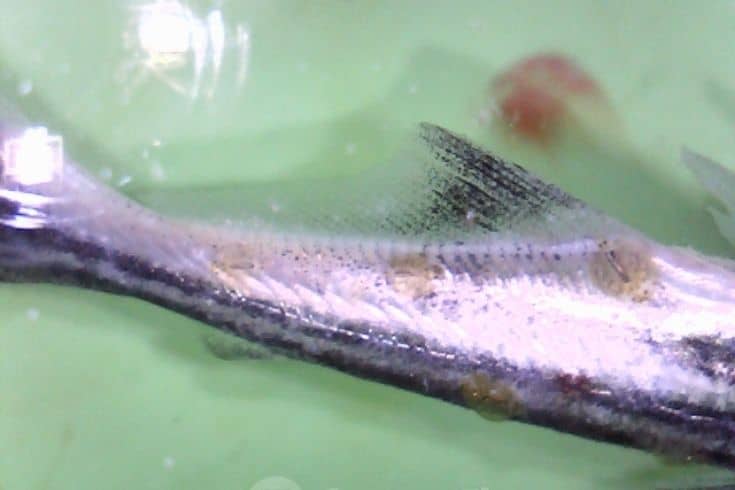
Causes:
Technically speaking, Ich is caused by the Ichthyophthirius multifiliis parasite. However, the parasite doesn’t just appear out of nowhere. It’s usually introduced to the tank via new fish, plants, or decorations. Once in the tank, the parasite can lay dormant for weeks or even months before attacking immunocompromised fish.
Treatment:
Thankfully, treating ich is fairly straightforward. The most common method is to raise the tank temperature to approximately 80 degrees Fahrenheit for 3-5 days. This speeds up the ich life cycle, causing the parasites to enter their infectious stage more quickly. At this point, they’re much easier to kill with medication.
Generally, medicines used to treat ich contain malachite green as an active ingredient. Another popular treatment method is to use a salt bath. While this is an excellent method of killing ich in salt-tolerant fish such as goldfish and cichlids, guppies are not salt-tolerant and should not be treated with this method.
2. Velvet (Oodinium)
Symptoms:
Velvet, or Oodinium, is another infectious fish disease easily recognizable by the telltale velvet-like coating it leaves on the fish’s body. This coating gives the fish a dusty, yellowish appearance and may also cause their fins to clump together.
In addition to the visible symptoms, sick fish will also exhibit behavioral changes. They may become more lethargic than usual and have trouble swimming. Their appetite will also diminish and they may stop eating altogether.
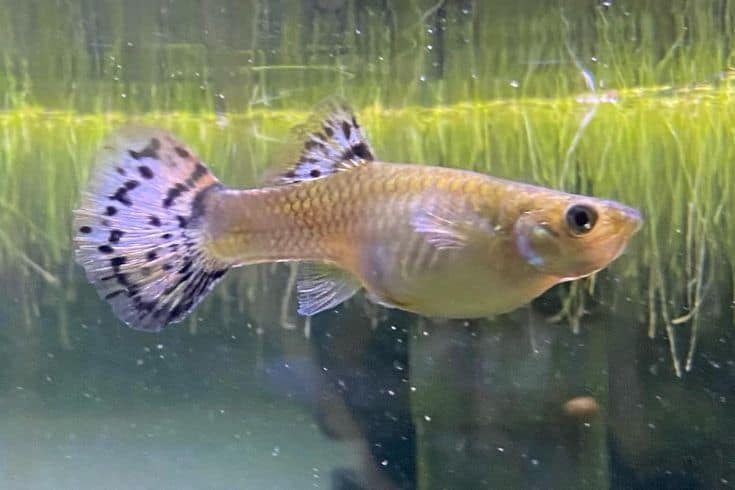
Causes:
Like ich, velvet is caused by a swimming parasite. In this case, it’s the Oodinium ocellatum. As with ich, new fish, plants, or decorations typically introduce velvet to the tank. Fish kept in dirty water are more susceptible to infection.
Treatment:
Fortunately, treating velvet is very similar to treating ich. You can use special medicines prescribed by a vet or an OTC copper medicine. Do a partial water change, and frequently test your water parameters over treatment.
3. Fin, Tail Rot
Symptoms:
Oof. It’s usually pretty easy to tell when your guppy has a tail or fin rot. Healthy guppies have fins that are rounded and fully intact. On the other hand, infected guppies have fins that look ragged, shredded, or may even be, in extreme cases, rotting away.
Not only is this a pretty gruesome sight, but it can also be painful for your guppy. In most cases, fin rot begins at the fish fins and tails, but progresses quickly and can affect the entire body if left untreated. Over time, it can be fatal, so please – act quickly.
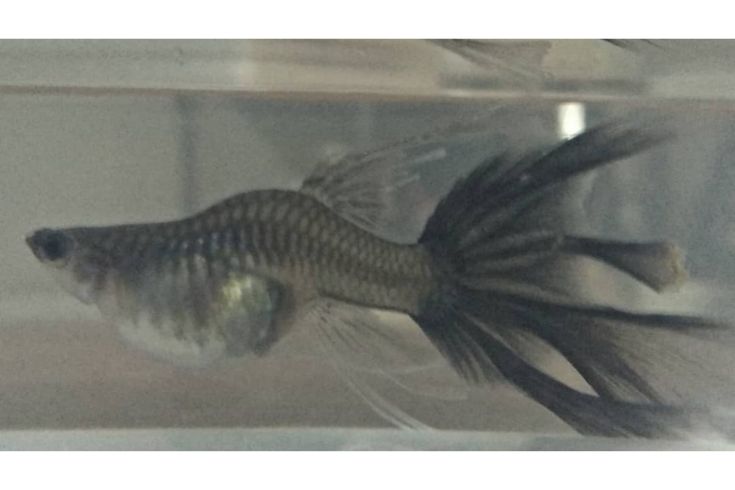
Causes:
Fin and tail rot is a common disease caused by a bacterial infection, usually Pseudomonas or Aeromonas. The bacteria enter the fish through open wounds, such as those caused by fighting or scraping against objects in the tank. Once inside, the bacteria multiply quickly and begin to eat away at the fins and tail.
Treatment:
Fortunately, treating fin and tail rot is fairly straightforward. The most common method is to use a medication that contains the antibiotic nitrofurazone. There are a number of commercial medications available, or your vet can prescribe one.
Some fishkeepers also find it helpful to remove fish waste from the tank and perform a huge water change. Clean water can often work wonders!
4. Guppy Disease (Tetrahymena)
Symptoms:
Tetrahymena is a fairly common guppy disease that’s easily recognizable by the white spots it leaves on the fish body. These spots are actually cysts that contain the Tetrahymena parasite. When the cysts burst, the parasites are released into the aquarium water where they can infect other fish.
In addition to the white spots, fish with Tetrahymena infections may also gasp for air, breathe heavily, or exhibit clamped fins.

Causes:
Tetrahymena infections are caused by, you guessed it, the Tetrahymena parasite. This parasite exists naturally in most freshwater environments and doesn’t usually cause problems in hardy fish such as guppies.
The trouble starts when your fish are weakened or already have preexisting health problems. In these cases, the Tetrahymena will take advantage of your pet’s compromised immune system and begin to multiply.
Treatment:
Treating Tetrahymena is a bit more complicated than some of the other guppy diseases on this list. Some aquarists have success with general-purpose anti-parasitic medication, but these are not always effective.
Therefore, we recommend raising healthy fish to begin with. Keep your tank water clean and free from any kind of water pollution, and your guppies will be just fine.
5. Columnaris & Mouth Fungus
Symptoms:
Columnaris is a bacterial infection that can affect your fish’s skin, fins, and gills. The most common symptom is a gray or white fuzz or film that covers the affected areas. In advanced cases, Columnaris can cause ulcers and open wounds.
Mouth fungus has similar symptoms, but as the name implies, it affects the mouth. In addition to the fuzz or film, you may also see white spots on the lips or inside the mouth.

Causes:
Columnaris and mouth fungus are both caused by the bacteria Flexibacter columnaris. This bacteria attacks fish kept in tanks with poor water conditions. High levels of ammonia, nitrites, or nitrates in the water create an ideal environment for the Flexibacter columnaris to thrive.
In addition, poor nutrition, or water temperatures that are too cold or hot can also make your fish more susceptible to Columnaris and mouth fungus.
Treatment:
A Terramycin bath is especially effective against Columnaris. Other options include copper medication, acriflavine, Furan, or a proprietary combination of different substances. API’s Melafix is one such product, and it’s effective against both Columnaris and mouth fungus.
In some cases, a simple water change followed by a week of diligent monitoring may be all that’s needed to clear up an infection. However, different fish react differently to Columnaris and mouth fungus, so it’s always best to avoid caution and treat the infection as soon as possible.
6. Dropsy
Symptoms:
Have you ever seen a pinecone? Notice the way the scales stand out from the body? That’s what Dropsy looks like. Your fish’s abdomen swells up with fluid until the scales are pushed outward, thus earning this disease the nickname “pinecone disease.”
In addition to the swelling, guppies with Dropsy may have bulging eyes, clamped fins, and an overall lethargic appearance. You may also notice redness on its body and an increased respiratory rate. This disease brings many different symptoms because the causes and severity of the swelling may cause different organs to fail.

Causes:
Think of dropsy as a very obvious and severe symptom of another disease or condition. In other words, it’s not a disease in and of itself but rather a sign that something else is going on. Unfortunately, this means that dropsy can be caused by a wide range of illnesses, including:
- Liver dysfunction
- Bacterial infections
- Fungal infections
- Parasitic disease
More broadly speaking, any disease or condition compromising the immune system can lead to dropsy. This includes everything from malnutrition to stress. Acute, or a one-time, brief period of stress is unlikely to lead to dropsy. Chronic stress, however, can devastate your fish’s health and make it susceptible to all sorts of diseases.
Treatment:
Dropsy is notoriously difficult to treat. In most cases, it’s too late to do anything when the fish shows signs of Dropsy. However, if you catch it early enough, you may be able to save your fish with antibiotics. The best course of action is to take your fish to a vet who can properly diagnose and treat the underlying condition.
A word of caution: Many times, fish are subject to multiple diseases at once. If your fish has Dropsy, there’s a good chance it also has another disease. Treating dropsy without treating the underlying cause is likely to be unsuccessful, so please don’t hesitate to visit a vet.
7. Swollen Gills and Gasping
Symptoms:
One of the most common signs that something is wrong with your guppy is if it’s gasping at the surface of the water. This is usually a sign that the gills are not getting enough oxygen. In addition to gasping, you may notice your fish has pale gills, is lethargic, or has trouble swimming. A fish suffering from gill damage will also have trouble eating.
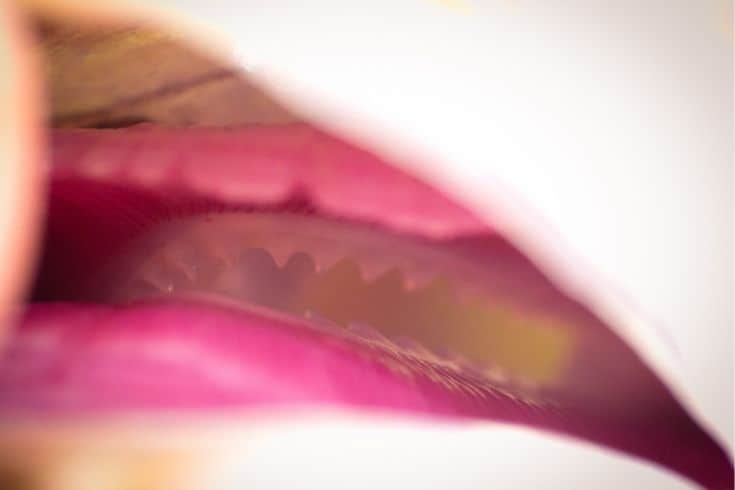
You may also see other symptoms depending on the underlying cause of the gill damage. These secondary symptoms are oftentimes more useful in diagnosing the cause of the gill damage than the gills themselves. For example, if your fish has been scratching itself a lot, it may have parasites. It may have a bacterial infection if it has red lesions on its body.
Causes:
Because swollen gills and gasping are such general symptoms, they can be caused by a number of different things. The most common causes are:
- Poor water quality
- Inadequate oxygen
- Bacterial infections
- Fungal infections
- Ammonia poisoning
Properly aerating your tank and doing regular water changes are the best ways to prevent gill damage. However, if your fish is already showing signs of gill damage, it’s important to act quickly to determine the underlying cause.
Treatment:
The treatment for gill damage will vary depending on the underlying cause. Generally, you should start by cleaning up your fish aquarium and ensuring the water quality is up to par. You could also move your sick guppy fish to a hospital tank where you can better control the water quality.
Using a hospital tank also makes it easier to observe your guppy for other symptoms without having to search for them in a large tank. Once you’ve identified the underlying cause of the gill damage, you can start treating it accordingly.
8. Red Blood Spot on Guppy Stomach/Body
Symptoms:
As the name suggests, a red blood spot on guppy fish is a small, bright red spot on the body, stomach, or tail. In some cases, you may see multiple red spots. The spots are usually about the size of a pinhead.
Causes:
A few different things can cause red blood spots on guppy fish. The most common are:
- A bacterial infection
- A fungal infection
- Physical trauma
Because the underlying causes are so diverse, it can be challenging to determine what’s causing the red blood spots without further investigation. We recommend taking your fish to a vet or experienced aquarium owner for further diagnosis.
Treatment:
The treatment for red blood spots will vary depending on the underlying cause. If you suspect your fish has a bacterial or fungal infection, you should treat the entire aquarium with a broad-spectrum antibiotic or antifungal. If the red blood spots are due to physical trauma, there’s not much you can do besides giving your fish time to heal.
9. Viral Haemorrhagic Septicaemia (VHS)
Symptoms:
Viral Haemorrhagic Septicaemia (VHS) is a highly contagious viral infection that affects fish. The most common symptoms are:
- Bleeding from the gills, eyes, and fins
- Lethargy
- Loss of appetite
If left untreated, VHS can quickly lead to death. Because it is so contagious, it’s important to act quickly if you think your fish may be infected.
Causes:
VHS is caused by a virus found in fresh, salt, and brackish water. The virus can infect a wide variety of fish, but guppy fish are particularly susceptible. VHS is often spread through contaminated water or contact with infected fish.
Treatment:
Unfortunately, there is no cure for VHS. Once a fish is infected, the best you can do is try to keep it comfortable and quarantined from other fish. VHS is incredibly contagious, so it’s important to take precautions to prevent the virus from spreading to other fish in your aquarium. Culling infected fish is often the best course of action to prevent the virus from spreading.
10. Popped Eyes
Symptoms:
Fish pop-eye, also known as exophthalmia, is a condition in which the eyes protrude from the sockets. Your guppy’s eyes will look larger than normal and appear bulging. The condition can affect one or both eyes. In most cases, the eyes simply bulge, but remain clear and functional. However, the eyeball may have a cloudy or milky appearance in severe cases, causing blindness.
Because of the discomfort caused by popeye, your pet fish may display reduced activity levels. The loss of appetite, particularly in severe cases, can also lead to weight loss.
Causes:
There are a number of different things that can cause popeye in guppies. The most common cause is poor water quality. Many guppies also injure themselves by swimming into things or getting nipped by other fish. Infections, both bacterial and fungal, are also common causes of popeye.
Treatment:
The first step in treating popeye is improving your tank’s water quality. This includes doing regular water changes and ensuring the filters are working properly. If you suspect an injury, try adding a small quantity of aquarium salt to the water. This can help to reduce swelling and inflammation.
If an infection causes popeye, you’ll need to treat the infection accordingly. This usually involves using a course of antibiotics.
11. Swim Bladder Disorder
Symptoms:
Much like dropsy, swim bladder disorder can cause your guppy to develop a swollen body. The difference is that, in this case, the bloating is not caused by fluid retention. Instead, it’s caused by a problem with the swim bladder, a organ that helps your fish to stay buoyant.

Other symptoms of swim bladder disorder include:
- Floating upside down
- Sinking to the bottom of the tank
- Difficulty swimming
- Swimming in a twisted or erratic manner
Again, the swim bladder helps your fish to maintain its balance. When it’s not functioning properly, these symptoms are very common.
Causes:
There are a range of factors that can cause swim bladder disorder. The most common cause is poor nutrition. Fish that are overfed, or fed bad-quality food, are more likely to develop swim bladder problems. This is because the constipation that can result from poor nutrition can put pressure on the swim bladder.
Infections, both bacterial and viral, can also cause the condition. In these cases, it is helpful to think of swim bladder disorder as a symptom of a larger problem. Once the infection is treated, the swim bladder disorder usually resolves itself.
Treatment:
The first step in treating swim bladder disorder is improving your guppy’s diet quality. This means feeding them smaller meals more often, and ensuring that they’re eating high-quality food. If there is an underlying infection, you’ll need to treat that accordingly. Be sure to place your fish in a separate tank before administering any medication.
12. Gill Flukes, Gill Worms
Symptoms:

Tiny, wriggling parasites, known as gill flukes or gill worms, are a common cause of problems in guppies. These parasites resemble white worms, and attach themselves to the gills and feed on your fish’s blood. This can cause a number of different symptoms, including:
- Rapid breathing
- Rubbing against objects in the tank
- Clamped fins
- Hanging at the water surface
- Loss of appetite
If you notice any of these symptoms in your guppy, it’s important to take action immediately. Left untreated, gill flukes can quickly lead to death.
Causes:
The culprit behind gill flukes is a parasitic flatworm known as the Monogenean fluke. These parasites are usually introduced to the tank via infected fish. Once in the tank, they attach themselves to the gills and begin feeding.
Treatment:
A commercial parasite treatment is the best way to treat gill flukes. These products are readily available at most pet stores. Be sure to follow the instructions carefully, as these products can be toxic to fish if used incorrectly.
13. Camallanus Internal Worm
Symptoms:
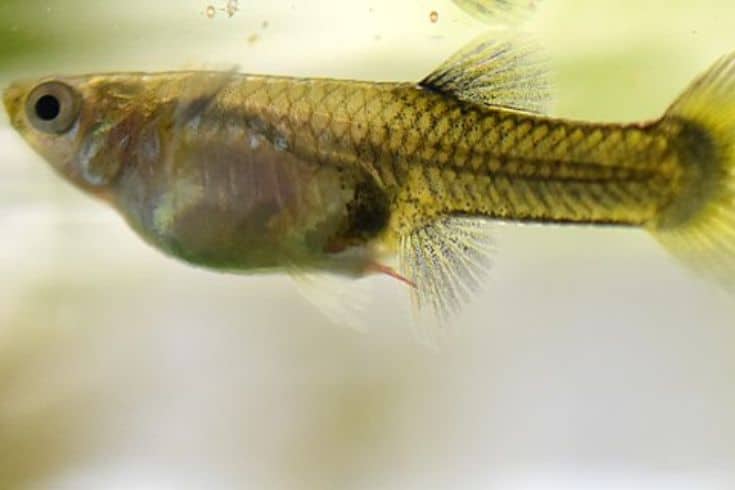
If your guppy is infected with Camallanus internal worms, you may notice a red, thread-like worm protruding from their anus. This is the most distinctive symptom of this particular infection, and it’s usually enough to diagnose the problem.
Causes:
Camallanus internal worms are usually found in infected crustaceans, such as shrimp or crayfish. These crustaceans can introduce the parasite to your tank, where it will then infect your fish.
Because these are internal parasites, it can be difficult to spot an infection until your fish displays external symptoms.
Treatment:
The best way to treat Camallanus internal worms is through commercial parasite treatment. These products are readily available at most pet stores. Be sure to follow the instructions carefully, as these products can be toxic to fish if used incorrectly.
14. Hexamitiasis – Hole in the Head or Body
Symptoms:

Hexamitiasis, commonly known as hole in the head or body, is a parasitic infection that can affect guppies. The most distinctive symptom of this condition is small holes or pits that form on the fish’s skin. These holes are usually most noticeable around the head and fins.
Causes:
Unless your fish has a literal hole in the head caused by an aggressive fish, the protozoan parasite Hexamita is the most common cause of hole in the head or body.
This parasite is usually present in fish tanks in safe, low levels. However, if the fish are stressed or have a weakened immune system, the parasite can begin to multiply and cause problems.
Treatment:
The best way to treat hole in the head or body is through commercial parasite treatment. These products are readily available at most pet stores. Do isolate your fish in a separate fish tank before using these treatments, as they can be toxic to other fish.
15. Bent Spine (Scoliosis)
Symptoms:

If you thought scoliosis was a human problem, think again! This condition can also affect guppies. The most distinctive symptom of scoliosis is a bent spine, resulting in other deformities such as a curved body or crooked fins.
Causes:
A birth deformity or genetic mutation usually causes scoliosis. Sometimes, it can also be caused by an injury or infection.
Treatment:
Unfortunately, there is no known cure for scoliosis. Most fish learn to adapt and live relatively normal lives despite their deformities. If the condition is severe, however, you may need to euthanize the fish to prevent it from suffering.
16. Fish Tuberculosis
Symptoms:
A Mycobacterium infection, commonly known as fish tuberculosis, can affect guppies. This condition impairs a fish’s ability to breathe, causing other symptoms such as labored breathing, lethargy, and, in severe cases, body lesions.
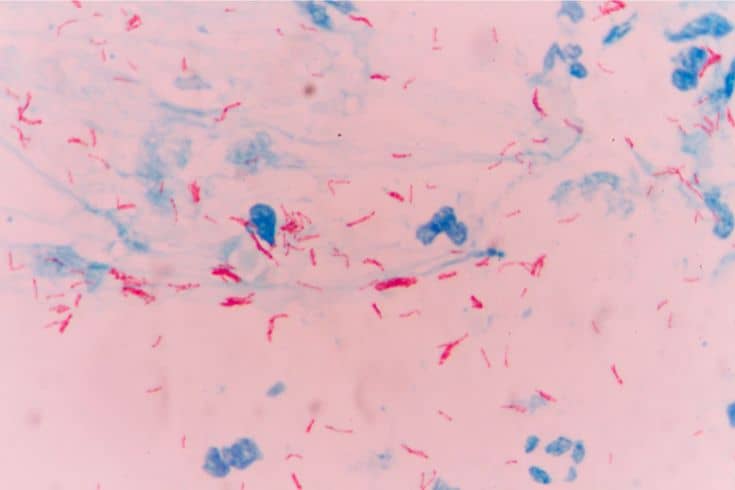
Causes:
Fish tuberculosis is usually caused by contact with infected fish or contaminated water. The bacteria can also be introduced to a tank via infected plants and other biological materials. Under very rare circumstances, guppy fish keepers inadvertently introduce the bacteria to their fish via contaminated hands or clothing.
Treatment:
Fish tuberculosis is a serious condition that often leads to death. There is no known treatment for the illness, though many fish do not suffer from any symptoms and merely have a shorter lifespan. Either way, the spread of this contagious disease is the best way to protect your fish colony from this potentially fatal condition.
17. Skinny Disease
Symptoms:
Last but not least, we have a disease that only affects livebearer fish. Also known as livebearer wasting disease, skinny disease is a condition that causes fish to waste away and eventually die. The most distinctive symptom of this disease is a sudden and rapid weight loss, hence the name.
Causes:
Poor water quality leads to stress in livebearers, making them more susceptible to skinny disease.
Treatment:
Stay on top of weekly water changes and vacuum the gravel to remove waste. Ensure that you have adequate filtration, and schedule regular filter cleanings as part of regular maintenance. Doing so will lead to an improvement in the environmental factors causing skinny disease in the first place, which should in turn lead to a full recovery.
The Takeaway
While many diseases can affect guppies, most of them are relatively easy to treat. By keeping your tank clean and monitoring your fish for signs of illness, you can help to keep your fish healthy and disease-free.
Have you ever dealt with a sick guppy? What was the diagnosis and treatment? Let us know in the comments below! And as always, thanks for reading!
